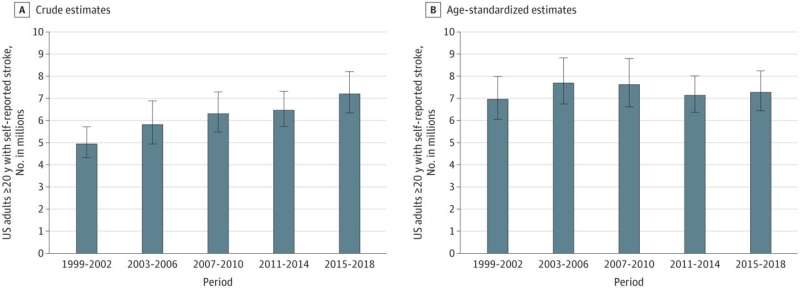
A trio of neurologists at the Perelman School of Medicine at the University of Pennsylvania has found through a study of the data in the National Health and Nutrition Examination Survey (NHANES) that the prevalence of stroke in the U.S. over the past 20 years has remained stable. Wells Andres, Aaron Rothstein and Holly Elser describe their analysis in the journal JAMA Neurology.
Stroke is a medical condition in which blood flow to parts of the brain becomes lost or restricted—the result is neural cell death, leaving those afflicted with minor to severe impairments. There are three main kinds of strokes: transient ischemic attack, in which an artery in the brain becomes blocked for a short period of time; ischemic stroke, which is roughly the same thing but the artery does not become unblocked on its own; and hemorrhagic stroke, in which a blood vessel in the brain bursts.
In this new effort, the researchers wondered if rates of stroke have been changing in recent years. To find out, they studied data from NHANES, a database created by the CDC’s National Center for Health Statistics, containing information collected every year to track health trends in the United States.
The group found that overall, prevalence of stroke remained steady over the years 1999 to 2018, when taking into account population growth. For the U.S. as a whole, the rate was found to be 2.84%, which, the team notes, describes between 7 and 8 million people. One group that saw a slight increase was men—for them, the rate increased from 2.9% to 3.1%.
The researchers note that reasons for or type of stroke were not included in their study, though they suggest that it is important that medical scientists continue to look for ways of preventing strokes altogether. They note also that, as in the past, most people who have a stroke are over the age of 60. They also note that it is possible the national average is slightly higher than their results suggested because data for people living in rehabilitation, long-term care, or medical facilities was not included.
More information:
Wells Andres et al, Trends in the Prevalence of Stroke Among Community-Dwelling Individuals in the US, 1999-2018, JAMA Neurology (2023). DOI: 10.1001/jamaneurol.2023.0742
Journal information:
Archives of Neurology
Source: Read Full Article